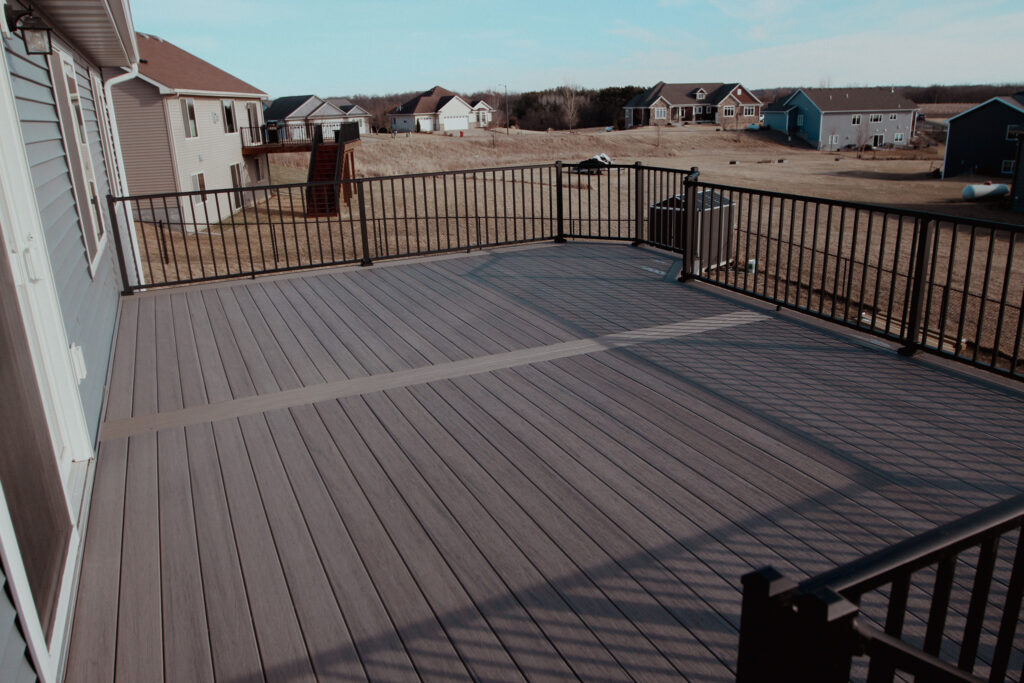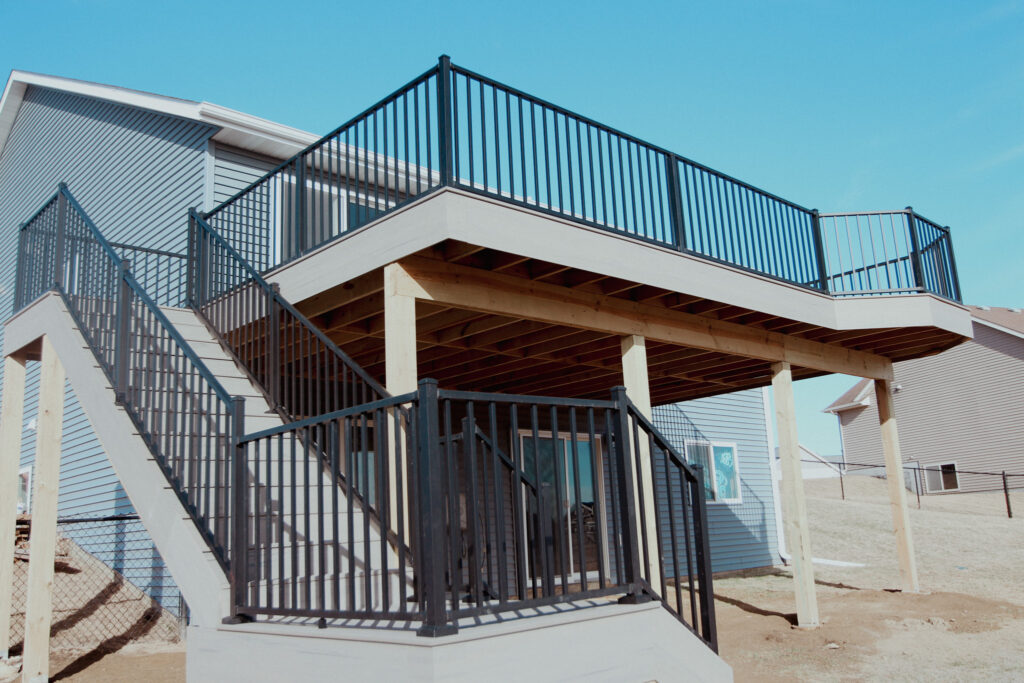Thinking of building a new deck? Find out how much a new deck costs, what impacts the price, and how long your deck will last be based on materials, maintenance, and climate.
If you’re considering adding a deck to your property, two questions typically rise to the top: What’s the investment, and what’s the expected lifespan? The answer, of course, hinges on a range of variables, everything from material and design, to your home’s location and your approach to maintenance. Let’s walk through the key factors, so you can make an informed, business-minded decision.
What’s the Average Cost of a New Deck?
Pricing fluctuates considerably depending on your selections. Here’s a breakdown of typical investment ranges by material:
Pressure-Treated Wood Deck
- Cost per square foot: $25–$45
- Average lifespan: 10–15 years
Composite Deck (e.g., Trex, TimberTech)
- Cost per square foot: $45–$70
- Average lifespan: 25–30 years
PVC or Vinyl Deck
- Cost per square foot: $55–$80
- Average lifespan: 30+ years
Hardwood Deck (e.g., Ipe, Mahogany)
- Cost per square foot: $65–$100+
- Average lifespan: 30–50 years
Aluminum Deck
- Cost per square foot: $70–$100+
- Average lifespan: 40–60 years
These figures generally cover the essentials: the deck structure, surface materials, hardware, and labor. Upgrades—such as custom railings, staircases, lighting, or pergolas—will add to your overall investment.

What Factors Affect the Cost of a Deck?
a. Size
Larger decks require more material and labor. A compact 10×10 platform may run under $5,000, while a sprawling, multi-level 20×30 deck with premium features can easily exceed $30,000.
b. Materials
Your choice of material is the primary cost driver. Pressure-treated wood is the most budget-friendly upfront but will require more regular maintenance. Composite and PVC options entail a higher initial investment but deliver longer lifespans and lower maintenance costs.
c. Design Complexity
The more complex the design, the higher the cost:
- Multi-level layouts
- Integrated seating or planters
- Deck skirting
- Diagonal decking patterns
- Inlay designs
Each of these adds labor time and material waste.
d. Foundation and Site Conditions
Uneven or unstable ground may require deeper footings or additional support, which can impact both the timeline and the budget.
e. Railings and Code Requirements
Most codes mandate railings, especially for elevated decks. Premium railings (metal or glass) can represent 15–25% of the total project cost.
f. Permits and Inspections
Most municipalities require permits for deck construction, particularly if the deck is attached or elevated. Permit costs vary, generally falling between $150–$800.
g. Contractor Experience and Warranty
Hiring an experienced, licensed contractor ensures code compliance and may include a workmanship warranty. While this increases upfront cost, it can mitigate long-term risk.
How Long Will My Deck Last?
Deck longevity is determined by material selection and maintenance practices:
Pressure-Treated Wood
- 10–15 years with regular sealing and repairs
- Requires annual cleaning and resealing every 2–3 years
- Susceptible to splinters, warping, and rot if not maintained properly
Composite Decking
- 25–30 years
- Mold, insect, and moisture-resistant
- Doesn’t require painting, staining, or sealing
PVC or Vinyl Decking
- 30–40+ years
- Completely waterproof and resistant to mold and mildew
- Some brands offer lifetime warranties
Hardwood Decking (Ipe, Cumaru)
- 30–50 years with regular oiling
- Naturally rot- and insect-resistant
- Requires specialized tools to install and maintain
Aluminum Decking
- 40–60 years
- Won’t rust, rot, warp, or crack
Fireproof and extremely low maintenance
How Can I Extend the Life of My Deck?
Regardless of the material you choose, proactive care is key for maximizing your investment.
For Wood Decks:
- Apply water-repellent sealant every 2–3 years
- Replace cracked or splintered boards promptly
- Keep leaves and debris off the surface
- Ensure joists and framing are not exposed to prolonged moisture
For Composite and PVC Decks:
- Sweep and hose down regularly
- Use composite-safe cleaners for stubborn grime
- Avoid sharp tools or abrasive cleaning pads
For All Deck Types:
- Use breathable rugs or mats to prevent mold growth
- Refasten loose screws or nails
- Check for signs of structural movement after seasonal changes
How Much Maintenance Does Each Deck Type Require?
Material | Annual Cleaning | Sealing/Staining | Expected Repairs |
Pressure-Treated Wood | ✅ | ✅ Every 2–3 years | Rot, cracking, warping |
Composite | ✅ | ❌ | Minor scratches |
PVC/Vinyl | ✅ | ❌ | Rare |
Hardwood | ✅ | ✅ Oiling yearly | Occasional board swaps |
Aluminum | ✅ | ❌ | Almost none |
Routine maintenance not only preserves your deck’s appearance and function, but also safeguards your investment for the long term. By choosing materials and features that align with your business goals—whether that’s return on investment, durability, or minimal upkeep—you position your property for years of reliable use and enhanced value.
FAQs About Deck Costs and Lifespan
Q: Is it less expensive to build a deck yourself?
A: Yes, you can reduce costs by about 30–50% by handling the labor yourself—provided you already have the right tools, skills, and enough time. But be careful: mistakes with structure or waterproofing can end up costing more in repairs or even cause code violations.
Q: Does a deck increase home value?
A: Absolutely. A well-constructed deck adds valuable outdoor living space and can recoup around 60–80% of its cost at resale. Buyers tend to gravitate toward homes with functional outdoor areas.
Q: What’s the most low-maintenance decking material?
A: Aluminum and PVC are top choices for minimal upkeep. These materials stand up well to moisture, sunlight, and temperature swings, and don’t require ongoing staining or sealing.
Q: How long does deck construction typically take?
A: Most professional contractors finish residential decks in 1–3 weeks, depending on project complexity, weather, required inspections, and scheduling. DIY projects often extend longer due to limited availability and planning time.
Q: Is winter deck construction possible?
A: Yes, it is feasible to build during winter, although cold or snowy conditions can cause delays. On the bright side, some contractors offer off-season pricing.

What Should Be Included in a Deck Quote?
A comprehensive deck quote should include:
- A detailed list of materials (framing, fasteners, decking boards, etc.)
- Labor costs
- Permit and inspection coordination
- Project timeline with start and finish dates
- Warranty information for materials and workmanship
- Cleanup and debris disposal
Having this level of detail up front helps prevent unexpected costs and ensures clear expectations.
Final Thoughts: Plan Strategically, Execute Professionally
Investing in a deck can significantly enhance your property’s livability and value. Whether you prefer the classic appeal of wood or the durability of modern composites, understanding both the costs and expected lifespan of your chosen materials will lead to better decision-making.
The most important steps are:
- Select materials that suit your budget and local climate
- Partner with an established, reputable contractor
- Plan for effective drainage and ventilation
- Maintain a consistent upkeep schedule
When all these elements are addressed, your new deck can become a standout feature of your home for many years.
